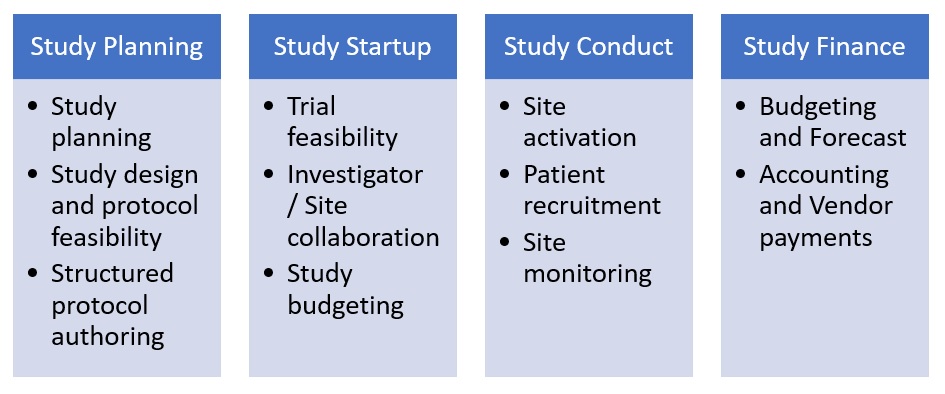Clinical trials are an expensive stage in a pharmaceutical product’s development. According to a recent study,1 it costs more than $2.6 billion to bring a drug to market. R&D costs play a significant role, as the industry spends more than $150 billion per year, and clinical development is nearly 70% of that cost.
Clinical trials management systems (CTMS) proliferate in every shape and hue to manage the complexity involved. Driven by demand for streamlined process efficiency and important statistics taken from top life sciences and biopharma companies, the clinical trial systems environment is changing rapidly.
In a 2018 Unified Clinical Operations Survey,2 life sciences computing service Veeva found that 99% of respondents had issues with an existing CTMS, of which almost 50% had issues with site/study management reporting while another 25% had issues with financial management.
In addition, the Clinical Data Interchange Standards Consortium and Center Watch survey3 found:
- 93% of biopharmaceutical organizations believe efficient interchange of clinical data among different parties is important
- 90% feel steps should be taken to improve data collection standards at the investigator site level
- 89% of site personnel feel sponsors should “collaborate in the standardization of electronic data collection practices and systems for investigative sites”
- 80% of sponsors and 81% of clinical technology service providers feel electronic source documentation should become the industry standard now or soon
- 70% of sponsors and 73% of site personnel feel this is a “key area where technology can better be leveraged in the future to support clinical research”
In order to bring new drugs and medical devices into the market, each product must be extensively tested to prove its safety and efficacy and uncover possible side effects in a clinical trial. Out of the four main phases clinical trials go through, Phase III trials include the greatest number of patients and are therefore demanding.
 Clinical trials require a lot of management. Aside from handling all the data from each phase, the procedure needs to be:
Clinical trials require a lot of management. Aside from handling all the data from each phase, the procedure needs to be:
- Secure
- Fast
- Cost-efficient
- Regulatory compliant
- Traceable
- Analyzable
- Achievable
- Transparent to different stakeholders
- Auditable
A tremendous amount of data is processed in clinical trials. Participant data, billing information, study design, milestones, deadlines, and financial management are just a few sources. It is becoming more difficult to manage all of this data, especially as the volume of clinical trials increases.
There is a growing need for transparent, clear, and easily accessible data for each aspect of a clinical trial. There are multiple niche specialist firms that cover each element—but in a siloed way.
Doctors, nurses, patients, pharmaceutical companies, and research centers are some of the stakeholders. All these stakeholders may use their own systems to store information. In addition, various stages of the trials have systems that create silos. Many times this results in repetitive data. In some cases, data are transcribed from system to system, resulting in a longer process and, potentially, errors.
 Starting from protocol design through study closeout, companies use different specialized systems in clinical trials. Each factor operates differently, and many companies use individual software programs for each function.
Starting from protocol design through study closeout, companies use different specialized systems in clinical trials. Each factor operates differently, and many companies use individual software programs for each function.
Initially, it is easier and more efficient to use a single best-of-breed approach for each function. However, as the company grows, more demand for integration of different functions and the need for data from different functions arises. This is where siloed systems fail, since different siloed systems are not compatible with one another.
Several market changes are impacting specialty therapies and personalized medicine. Also, new product offerings target specific biomarkers, such as biologic chemotherapy agents, or even individual patients, such as CAR-T immunotherapy. Similarly, therapies that combine mobile sensors and devices with drugs and delivery devices—such as apps assessing the daily effects of Parkinson’s or other mobility-restricting conditions—require evidence of real-world efficacy and safety that cannot be generated in a controlled environment.
By identifying the competitive advantage of each system and stage and combining them into a single integrated system, these elements can be fused together. Parties only need to enter data once. It will minimize cost, inventory, time, and other valuable resources. The various functions for the clinical trial should parallel and function as a whole to operate seamlessly.
With an integrated system, this can be done rapidly. If done correctly—with a blueprint for the big picture—new eClinical platforms can reduce redundancy and streamline effort, scaling study start-up processes from weeks to days or events to hours.
Some companies are already using integrated systems, but there is still a huge void in integrating financials—the most complex part of the clinical trial. Many healthcare companies such as Oracle, ClinCapture, Medrio, and Smartsheet have developed an integrated CTMS, but, there is no software that currently integrates the financial aspects of clinical trials. This accounts for a significant loss of time and money and needs additional reconciliation work.
Blockchain could be the answer for integrated eClinical trials
There is potential for CTMS to provide a centralized system where management can share payment calendars, billing procedures, sponsor invoicing, and subject visit tracking. Payout to volunteers, investigators, vendors, and regulatory agencies can all be tracked and managed under one integrated system. When there is a problem, there is no need to search every function to find the bug. Audit trails can be integrated, and data validity is enhanced.
When information is put into different software systems, there is bound to be some error. People make mistakes. With integrated systems, the room for error decreases enormously since the data are put in only once. They also eliminate any fraud that could occur in in the clutter of repeated information.
Seamless flow of clinical data to stakeholders with security, privacy, and accuracy is highly desirable in the conduct of clinical trials. Pharmaceutical companies, clinical research institutes, and hospitals spend billions of dollars and an enormous amount of time each year worldwide on conducting clinical trials to bring new and effective products to the market. A contributing factor to the rising costs and lengthy timelines of clinical trials is the decluttering, reentering, and translating data.
Blockchain technology has recently emerged as an alternative means for transferring data between participating parties based on a “distributed ledger” model that affords a fully transparent and immutable record of data transactions. A blockchain consists of consecutive chained blocks that are replicated on the nodes of a peer-to-peer network. Blocks consist of records, and each record contains details of a transaction between the users of the system. Blockchains are a distributed database, anchored by cryptography, where the data are stored immutably and are less vulnerable to hacking or manipulation.
As mentioned in research by Benchoufi and Ravoud, recently published in Blockchain technology for improving clinical research quality,4 “Reproducibility, data sharing, personal data privacy concerns, and patient enrollment in clinical trials are huge medical challenges for contemporary clinical research. A new technology, blockchain, may be a key to addressing these challenges and should draw the attention of the whole clinical research community.”
Existing CTMS have made significant progress in the last few years with electronic data capture and better forms of data recording and transcribing. Many such approaches continue to use risk-based human data verification and validation. Yet, as mentioned earlier, almost 99% of CTMS users in a Veeva study indicated a high degree of dissatisfaction with existing systems.
Furthermore, in a U.S. Society of Clinical Research (SCRS) sites survey,5 respondents were dissatisfied by payment delays. They indicated that while they expected to be paid within a month (77%), most were paid four to six months after the activity, while two-thirds of sites had only three months of operating cash. This suggests trial subjects were paid even later.
Researchers from McKinsey asserted6 that “in the short term blockchain strategy’s value is in cost reduction…by removing intermediaries or the administrative effort of recordkeeping and transaction reconciliation.”
Data integrity concerns have been highlighted by many authors. The Benchouffi and Ravaud study quotes a study by Loannaides et al.7 which suggested, “80% of trials are not reproducible due to errors, misconduct or fraud.” Another University of California at San Francisco (UCSF) study8 by Wong et al. indicated the rate of “data fraud could be as high as 17%.”
“Everyone is talking about how blockchain is going to revolutionize many of the data challenges in medicine, and here is one use that finally might make sense,” said Atul Butte, MD, PhD, director of the Bakar Computational Health Sciences Institute at University California, San Francisco (UCSF). “We think it could someday be useful for pharma companies running clinical trials.”
Integrated eClinical platforms based on technologies such as blockchain will need to offer common features and functions that support multiple processes and allow for shared datasets, so that data only must be entered once—not multiple times for every part of the process.
If done right—with an architecture for the complete picture—new eClinical platforms will reduce redundancy, streamline effort, and make the process of getting new drugs to market far less of a “trial.”
Rama Rao is CEO and co-founder of Bloqcube and Himanshu Jain is consulting director, life sciences and healthcare strategy and analytics at NTT DATA Services.
References
1. DiMasi JA , Grabowski HG, and Hansen RW. Innovation in the pharmaceutical industry: New estimates of R&D costs. Journal of Health Economics. 2016;47:20-33.
2. https://www.veeva.com/resources/industry-survey-shows-87-of-clinical-operations-leaders-taking-action-to-unify-clinical-processes/
3. https://www.mdconnectinc.com/medical-marketing-insights/data-inefficiencies-crippling-clinical-trial-outcomes
4. Mehdi B, Ravaud P. Blockchain technology for improving clinical research quality. Trials 2017;18. 10.1186/s13063-017-2035-z.
5. What Are The Financial Barriers To Site Sustainability, Patient Experience, & Overall Trial Success?
6. https://www.mckinsey.com/business-functions/digital-mckinsey/our-insights/blockchain-beyond-the-hype-what-is-the-strategic-business-value
7. Ioannidis JP. Why most published research findings are false. PLoS Med 2005; 2:e124
8. Wong DR, Bhattacharya S, Butte AJ. Prototype of running clinical trials in an untrustworthy environment using blockchain. Nat Commun. 2019;10(1):917. Published 2019 Feb 22. doi:10.1038/s41467-019-08874-y



